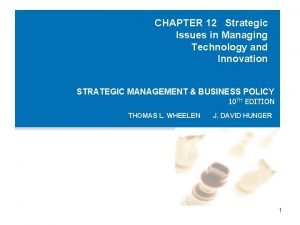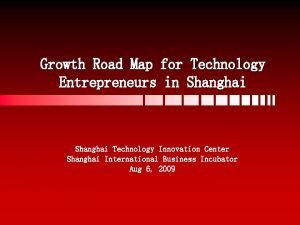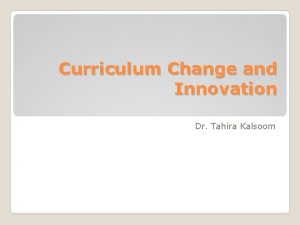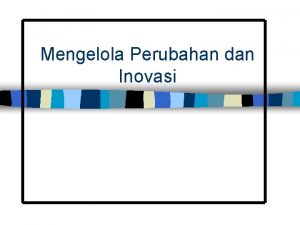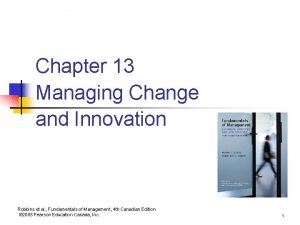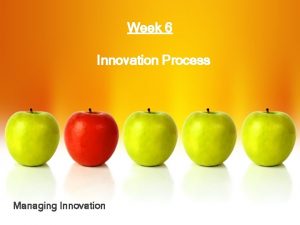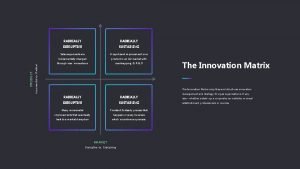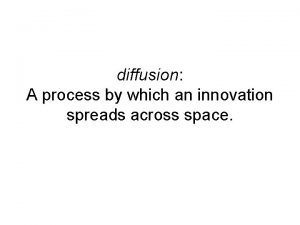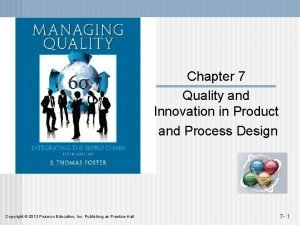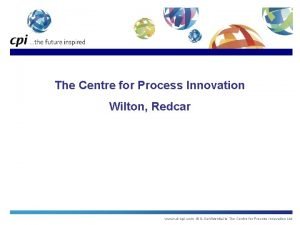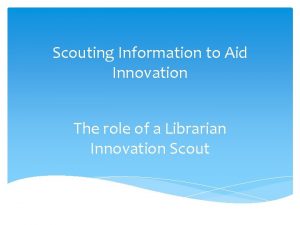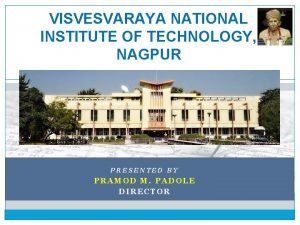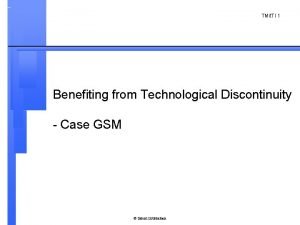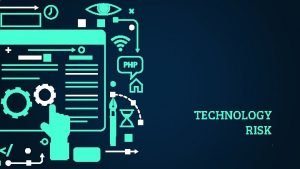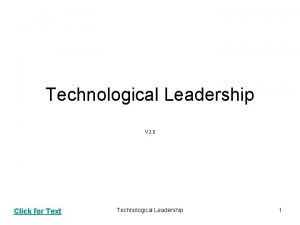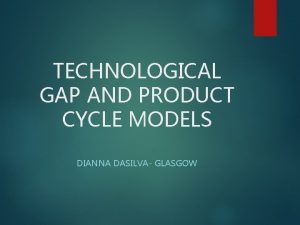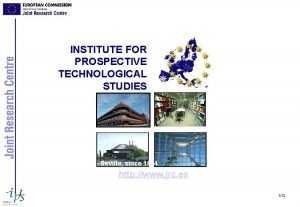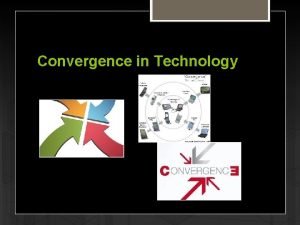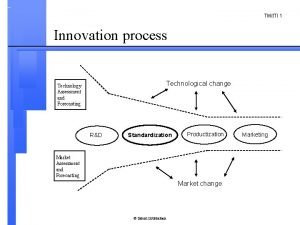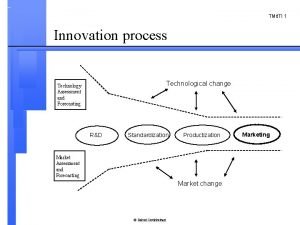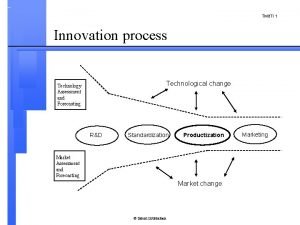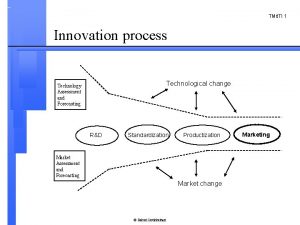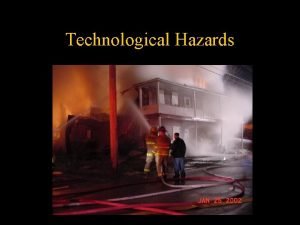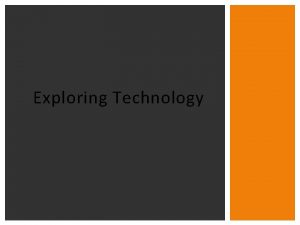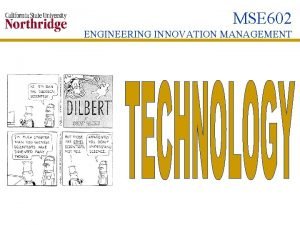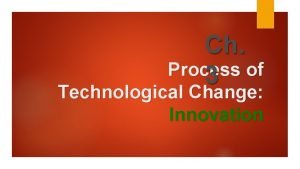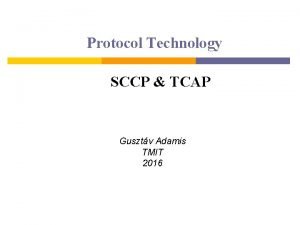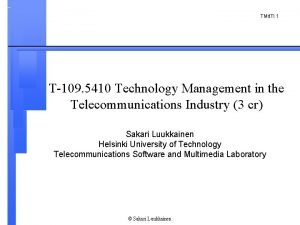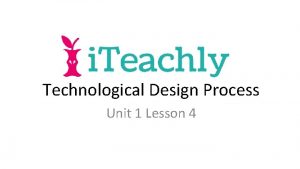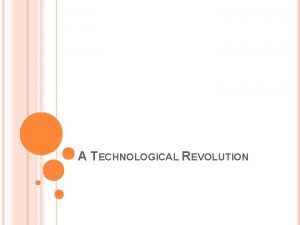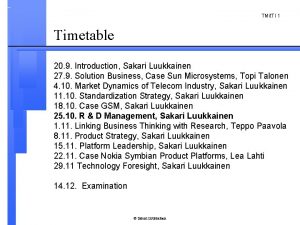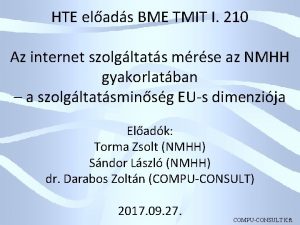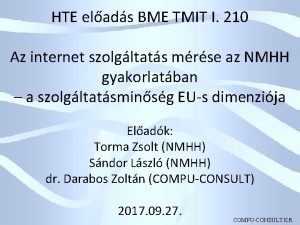TMit TI 1 Innovation process Technological change Technology



























- Slides: 27

TMit. TI 1 Innovation process Technological change Technology Assessment and Forecasting R&D Standardization Productization Market Assessment and Forecasting Market change © Sakari Luukkainen Marketing

TMit. TI 2 R&D Intensity by Country © Sakari Luukkainen Source: Tekes, OECD

TMit. TI 3 Goals of R&D Management Production ICT investment Innovation Proprietary technologies Value added Sales, profit R&D investment Generic technologies Science base © Sakari Luukkainen GDP

TMit. TI 4 R&D Life Cycle € R&D investment Time Science base Proprietary Generic technologies © Sakari Luukkainen Production scale-up

TMit. TI 5 R&D Life Cycle € R&D investment Commercialization investment Time Science base Proprietary Generic technologies © Sakari Luukkainen Production scale-up

TMit. TI 6 R&D Life Cycle € Commercialization investment R&D investment Cash flow Science base Proprietary Generic technologies © Sakari Luukkainen Sales Time Production scale-up Market penetration

TMit. TI 7 Technology strategy process in firms Autonomous strategic action Strategic context Concept of corporate strategy Induced strategic action Structural context Source: Burgelman & Rosenbloom 2001 © Sakari Luukkainen

Technology strategy enactment in firms TMit. TI 8 Induced • applied research on new technologies opportunities and threats to support existing and emerging businesses • standardization, alliances • product development • joint ventures • acquisitions Autonomous • science-based research • internal corporate venturing • external corporate venturing: VC, venturing alliances and if they fail the last change is followership by copying / contracting / licensing without timing and cost advantage © Sakari Luukkainen

TMit. TI 9 Classification of R&D Type of R&D Probability of technical success Incremental Discontinuous Fundamental 40 -80% 20 -40% Small, difficult to assess Time to completion 0, 1 -2 years 2 -4 years 5 -10 years Competitive potential Modest, but necessary Large, difficult to assess Durability of competitive advantage Short, imitable by competitors Long, protectable by patents Long but risky © Sakari Luukkainen Source: adapted from Pitkänen 2000, ADL 1991

TMit. TI 10 Core competencies © Sakari Luukkainen Source Prahalad & Hamel 2001

Overcommitment increase R&D cost and destroys productivity TMit. TI 11 Average value added time for engineering tasks 100 % 60 % 1 2 3 © Sakari Luukkainen 4 Number of projects per engineer Source: Henderson

TMit. TI 12 Innovation process in firms Technological change Technology Assessment and Forecasting Idea generation and screening Diversified portofolio of Project Plans Project execution and evaluation Market Assessment and Forecasting Market change © Sakari Luukkainen

TMit. TI 13 R&D Investment Profitability Evaluation Net Present Value (NPV, DCF) JAp St å ( 1 + i )t + ( 1 + i ) t =m p -å t =1 Ht ( 1+ i )t Internal Rate of Return (Ro. R, IRR) © Sakari Luukkainen

TMit. TI 14 Ro. R calculation formula m = the length of the R&D project n = the length of the product life-cycle p=m+n St = net cash flow after the market introduction Ro. R = rate of return Ht = annual R&D expenditure JAp = residual value © Sakari Luukkainen

TMit. TI 15 Real options based management approach limits the downside risk of an R&D investment decision by a staged product development process without limiting the upside potential by giving increasing flexibility to target actions according to the contingent evolution of technology and related market (Amram and Kulatilaka 1999, Gaynor 2003, Faulkner 1996). © Sakari Luukkainen

TMit. TI 16 Real options R&D valuation Initial R&D Investment Decision R&D Commercialization Outcome Decision Excellent Yes -$6 M Yes 0. 6 Good 0. 1 No Valuation Method DCF #1: Use most likely values DCF #2: Consider market uncertainty DCF #3: Consider all uncertainties Options Thinking Valuation Yes 0. 8 -$15 M 0. 2 No 0. 3 -$15 M No Yes Poor NPV - $11. 4 - $9. 0 - $5. 4 + $2. 2 © Sakari Luukkainen Market Outcome +$60 M -$15 M 0. 3 0. 7 0. 1 0. 9 No 1993 1994 +$15 M +$20 M +$10 M -$15 M -$60 M 1995 - 6 -(15/1. 12) + (10/1. 12 2) - 6 -(15/1. 12) + (0. 3*20+0. 7*10)/1. 12 2 - 6 -(15/1. 12) + 0. 3(0. 8*…. )/1. 12 2 - 6 -0. 3*(15/1. 12)+0. 3*((0. 8*60+0. 2*15)/1. 122)) Source: Faulkner 1996

TMit. TI 17 QFD-method © Sakari Luukkainen Source: Lowe & Ridgway, University of Sheffield

TMit. TI 18 Goals of Technology Policy • Annaul R&D investments in Finland are about 5 billion € of which was publicly financed 28 %, major R&D performed in telecom sector • Technology policy differs from the other policies, because it tryis to "increase the cake" instead of sharing it • The most important reasons for too low a level of the private R&D investments are due to the high technical and commercial risks involved • The government´s initiative is thus emphasized in the case of R&D underinvestment in the private sector • In order to redress this kind of market failure the industrial countries have contributed to their technological infrastructure to support the long-term competitiveness of domestic companies © Sakari Luukkainen

TMit. TI 19 Goals of Technology Policy • Companies make their decisions of the R&D investments aiming at maximizing profits • Therefore, at least in big companies, the risk is divided into the portfolios of many different R&D projects, all of which are required greater profitability than other less risky projects like the expansion of the present production facilities • This all results in the companies beginning to favour R&D projects with a short time to market influence. • Therefore the goal of technology policy is to maximize the influence of such R&D investments on the growth of GDP, which would not be realised without support, but would greatly benefit society © Sakari Luukkainen

TMit. TI 20 Goals of Technology Policy • Spillover means practically a situation where investment in the technology of an innovator also benefits other companies • Economists have demonstrated that R&D performed by the original innovating company generates widespread value in the economy through spillovers • The key factor in the development of the industrial structure and advancement of spillovers is the efficiency of the whole domestic value chain (cluster) • Concrete technology policy occurs in the selection of publicly financed R&D projects © Sakari Luukkainen

TMit. TI 21 Example value chain Supplier A Firm B Customer C Supplier D Firm E Customer F Supplier G Firm H Customer I Supply chain Core industry © Sakari Luukkainen Services

Telecommunications value chain Telecluster TMit. TI 22 Content providers Mechanics producers Semiconductor producers Circuit board producers Network operator Service operator Consumers Telecom industry Business services Banking, health care, traffic… Circuit board installation © Sakari Luukkainen Software companies

TMit. TI 23 R&D financing by type of project Social rate of return A D B Social hurdle rate C E Innovator hurdle rate © Sakari Luukkainen Innovator rate of return Source: Tassey 1997

TMit. TI 24 R&D management by milestones Social rate of return Social hurdle rate At 1 At 21 At 3 At 22 Innovator hurdle rate © Sakari Luukkainen Evaluation of - profitability - technical risk - delay Decisions on - continue - modify - kill / freeze Innovator rate of return Source: Tassey 1997

TMit. TI 25 Finnish Innovation System © Sakari Luukkainen Source: Tekes

TMit. TI 26 Evaluation of the Innovation System • R&D investments of industry has been successfull - R&D expenditures correlate highly with growth of sales of new products i. e. innovations • The public support of GSM development has created a lot of direct success as well as spillovers in the telecluster • The role of basic research has been low in the ICT business so far • The effect of public financing has had a significant but limited effect, it works in firms that already have high R&D intensity – successful R&D requires process knowledge (Niininen 1999) © Sakari Luukkainen

TMit. TI 27 Evaluation of the Innovation System • Subsidized loans have better effect on productivity than direct support – easy money effect (Niininen 1999) • The role of liquidity constraints was negligible in determining R&D investment – steady R&D spending (Niininen 1999) • Venture capital financing has so far resulted in a very few new success stories • Financing by own cashflow puts more pressures to allocate R&D according to market need © Sakari Luukkainen
 The importance of technology
The importance of technology Neil postman five things
Neil postman five things Mysite socccd
Mysite socccd Radical vs disruptive innovation
Radical vs disruptive innovation Design process
Design process Technology forecasting examples
Technology forecasting examples Strategic issues in managing technology and innovation
Strategic issues in managing technology and innovation Shanghai technology innovation center
Shanghai technology innovation center Linkage model in curriculum
Linkage model in curriculum 2 metafora mengenai proses perubahan
2 metafora mengenai proses perubahan Chapter 13 managing change and innovation
Chapter 13 managing change and innovation The calm waters metaphor
The calm waters metaphor Innovation portal info
Innovation portal info Sustaining vs incremental innovation
Sustaining vs incremental innovation Expansion diffusion
Expansion diffusion Quality and innovation in product and process design
Quality and innovation in product and process design Centre for process innovation limited
Centre for process innovation limited Innovation scouting process
Innovation scouting process Visvesvaraya technological university nagpur
Visvesvaraya technological university nagpur Technological discontinuity definition
Technological discontinuity definition Technology risk examples
Technology risk examples Technological modelling
Technological modelling Technological leader
Technological leader Technology gap model
Technology gap model Political economic
Political economic Institute for prospective technological studies
Institute for prospective technological studies Smartphones are an example of technological convergence
Smartphones are an example of technological convergence What is business
What is business






